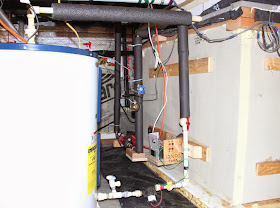The new backup heat system is pretty simple. Its just an electric hot water heater that sits next to the solar tank with a small pump to circulate hot water from the electric tank to the solar tank when the solar tank temperature drops below a setpoint. The heat is distributed to the room above by the same radiant floor pex tube system as before.
 |
| The backup heat source electric hot water tank |
 |
| The TopsFlo pump that circulates water between the backup tank and the solar tank is at the bottom of the picture -- only 15 watts. |
 |
| Diagram of the new backup heat system -- really simple. |
I've added a new page that describes the backup system here...
And, updated a few pages for the project to reflect the new backup heat system...
There is also some discussion of other alternative backup heating systems -- I'd be interested in hearing any ideas on a better way to do it.
Gary




